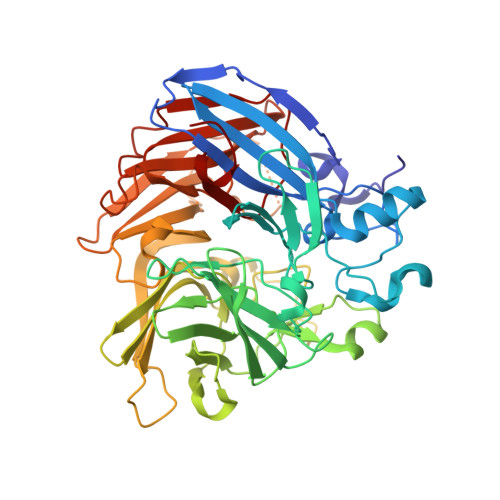Structural and functional analysis of lignostilbene dioxygenases from Sphingobium sp. SYK-6.
Kuatsjah, E., Chan, A.C.K., Katahira, R., Haugen, S.J., Beckham, G.T., Murphy, M.E.P., Eltis, L.D.(2021) J Biological Chem 296: 100758-100758
- PubMed: 33965373
- DOI: https://doi.org/10.1016/j.jbc.2021.100758
- Primary Citation of Related Structures:
6XM6, 6XM7, 6XM8, 6XM9, 6XMA - PubMed Abstract:
Lignostilbene-α,β-dioxygenases (LSDs) are iron-dependent oxygenases involved in the catabolism of lignin-derived stilbenes. Sphingobium sp. SYK-6 contains eight LSD homologs with undetermined physiological roles. To investigate which homologs are involved in the catabolism of dehydrodiconiferyl alcohol (DCA), derived from β-5 linked lignin subunits, we heterologously produced the enzymes and screened their activities in lysates. The seven soluble enzymes all cleaved lignostilbene, but only LSD2, LSD3, and LSD4 exhibited high specific activity for 3-(4-hydroxy-3-(4-hydroxy-3-methoxystyryl)-5-methoxyphenyl) acrylate (DCA-S) relative to lignostilbene. LSD4 catalyzed the cleavage of DCA-S to 5-formylferulate and vanillin and cleaved lignostilbene and DCA-S (∼10 6 M -1 s -1 ) with tenfold greater specificity than pterostilbene and resveratrol. X-ray crystal structures of native LSD4 and the catalytically inactive cobalt-substituted Co-LSD4 at 1.45 Å resolution revealed the same fold, metal ion coordination, and edge-to-edge dimeric structure as observed in related enzymes. Key catalytic residues, Phe-59, Tyr-101, and Lys-134, were also conserved. Structures of Co-LSD4·vanillin, Co-LSD4·lignostilbene, and Co-LSD4·DCA-S complexes revealed that Ser-283 forms a hydrogen bond with the hydroxyl group of the ferulyl portion of DCA-S. This residue is conserved in LSD2 and LSD4 but is alanine in LSD3. Substitution of Ser-283 with Ala minimally affected the specificity of LSD4 for either lignostilbene or DCA-S. By contrast, substitution with phenylalanine, as occurs in LSD5 and LSD6, reduced the specificity of the enzyme for both substrates by an order of magnitude. This study expands our understanding of an LSD critical to DCA catabolism as well as the physiological roles of other LSDs and their determinants of substrate specificity.
- Department of Microbiology and Immunology, Life Sciences Institute, The University of British Columbia, Vancouver, Canada; Renewable Resources and Enabling Sciences Center, National Renewable Energy Laboratory, Golden, Colorado, USA; Center for Bioenergy Innovation, Oak Ridge National Laboratory, Oak Ridge Tennessee, USA.
Organizational Affiliation:




















